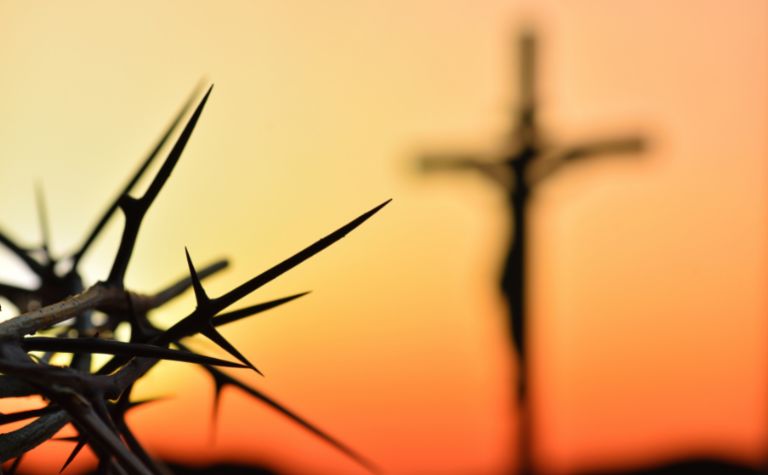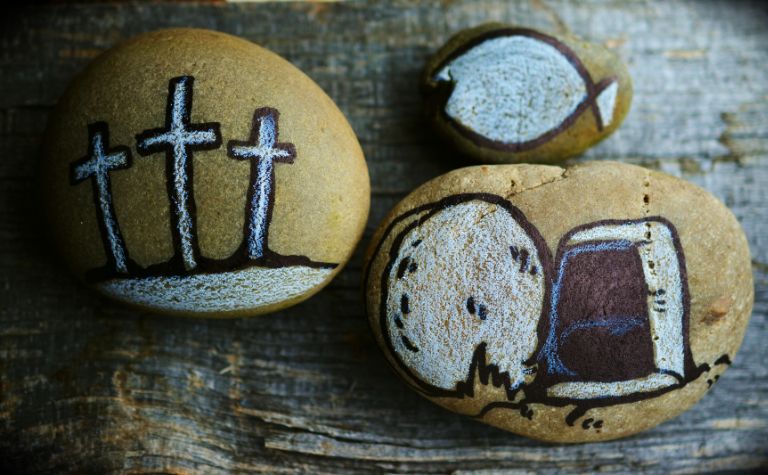Every Spring worldwide, millions of people observe Easter. Christians celebrate the resurrection of Jesus Christ in churches and their homes because it’s the historical and spiritual reason for the special Sunday. Others, some of whom don’t believe in Jesus, observe the day with traditions involving the Easter Bunny, decorating chicken eggs, and hiding candy for children to find.
Below, readers will find 22 facts about Easter that answer questions like: Why does the date for Easter change every year? Who decides when Easter will be? What does the Easter Bunny have to do with Jesus’ resurrection? What do eggs have to do with bunnies? Who did Jesus first appear to after he rose? What did he do after his resurrection? Keep reading to find out the answers to these questions and others.
Also, many people incorporate the Easter Bunny into their celebration of Easter. Yet others wonder what the Easter Bunny has to do with Jesus Christ and his resurrection from the dead.
1. Jesus’ resurrection is the heart of Christianity
Paul wrote to the Christians at Corinth that if Jesus didn’t rise from the dead, the faith of all believers would be worthless: “And if Christ has not been raised, your faith is futile and you are still in your sins” (1 Cor. 15:17). The Greek word translated “futile” (ESV, NIV, NKJV), “vain” (KJV), or “useless” (NLT) is mataios (μάταιος) and refers to something that has no purpose.

2. Jesus physically rose from the dead
Jesus’ resurrection was physical. Those who contend it was merely spiritual misread the New Testament. Jesus’ followers, as well as skeptics and doubters, saw him with their eyes, heard him with their ears, and even touched him.
For example, Thomas refused to believe until he had physical proof: “Unless I see in his hands the mark of the nails, and place my finger into the mark of the nails, and place my hand into his side, I will never believe” (John 20:25).
Soon, Jesus approached Thomas, saying, “Then he said to Thomas, ‘Put your finger here, and see my hands; and put out your hand, and place it in my side. Do not disbelieve, but believe.’ Thomas answered him, ‘My Lord and my God!’ Jesus said to him, ‘Have you believed because you have seen me? Blessed are those who have not seen and yet have believed'” (John 20:27-29).
Also, to some people, Easter is about bunnies and candy. In contrast, learn the spiritual meaning of Easter and why the Bible says it’s so important.
3. Jesus rose from the dead during Passover
Jesus died on the cross being during the annual Passover festival (e.g., Matt. 26:17-26; John 19:14). The New Testament presents Jesus as God’s true and ultimate sacrificial lamb (cf. John 1:29; 19:14). Paul describes this theme when he writes, “Cleanse out the old leaven that you may be a new lump, as you really are unleavened. For Christ, our Passover lamb, has been sacrificed” (1 Cor. 5:7, ESV, emphasis added).
4. The word Easter doesn’t appear in the Greek New Testament
The word “Easter” doesn’t appear in the original languages of the Bible and wasn’t in common use until several centuries after the resurrection of Jesus Christ. However, the translators of the King James Version (KJV) in 17th-century England decided to use “Easter” in one verse to render a Greek word describing Passover.
Acts 12:4 reads, “And when [Herod] had apprehended [Peter], he put him in prison, and delivered him to four quaternions of soldiers to keep him; intending after Easter to bring him forth to the people” (KJV). The Greek word translated as “Easter” (pascha) means “passover.” The other 28 times pascha appears in the New Testament, the KJV translates it as “passover” (e.g. John 2:23; Heb. 11:28).

5. The word Easter comes from European paganism
The Oxford Dictionary of Christianity cites the work of an English monk named Bede to explain the word history or etymology of “Easter.” It reads, “The derivation of the name ‘Easter” is uncertain. According to Bede (672-735 A.D.), it is connected with an Anglo-Saxon spring goddess ‘Eostere.'” [1] The dictionary explains that Resurrection Sunday in England replaced an old pagan festival that included goddesses.
6. The date for Easter changes every year
Easter can fall anywhere between March 22 and April 25. The date of Easter is the first Sunday after the first “paschal full moon” after March 21. March 21 is the fixed date of the Spring Equinox in the northern hemisphere on the Gregorian calendar. “Paschal” comes from the Latin word “Pascha,” meaning “Feast of Passover.” “Full moon” doesn’t refer to a literal full moon but to the date 14 Nisan on the Jewish calendar.
Also, Catholics and Protestants have similarities and differences. One question Protestants sometimes ask is if Roman Catholics celebrate Easter.
7. The Council of Nicaea decided the date for Easter
The Western church decided the date for Easter in the fourth century at the Council of Nicaea. This meeting was the first of several important councils that church leaders held to articulate doctrine and settle disputes in the first few centuries of the Christian church. Nicaea was a town in Asia Minor that today is called Iznik, Turkey. Historians estimate that 300 leaders attended the council.
8. All Christian branches and denominations celebrate Easter
The three historic branches of Christianity, which are Roman Catholicism, Eastern Orthodoxy, and Protestantism, celebrate Jesus’ resurrection. Additionally, all major denominations within Protestantism, including Lutheran, Reformed, Presbyterian, Anglican, Methodist, Episcopalian, Baptist, Assemblies of God, orthodox non-denominational churches, and many others, also celebrate Easter.
9. Catholics and Protestants Celebrate Easter on the same date
While Catholic and Protestant churches use the same formula to determine the date of Easter each year, Eastern Orthodoxy doesn’t. This is because the Julian Calendar, which the Greek Orthodox Church uses, is about two weeks behind the Gregorian, which Roman Catholic and Protestant churches use. This difference means Easter occurs later in some countries, such as Greece.

10. The Easter Bunny may relate to Jesus’ mother, Mary
To some Christians in the Middle Ages, hares represented producing offspring without mating because people at the time incorrectly thought they were hermaphrodites (i.e., they self-conceived). Some leaders in the church thought this was analogous to Mary giving birth to Jesus since the Bible teaches that she was a virgin at the time of her conception.
11. Easter Eggs may be symbolic of fertility
Since hares don’t lay eggs, many wonder how the Easter Bunny became associated with them. Though the historical connection is uncertain, they are both symbols of fertility because hares have lots of bunnies, and chickens lay lots of eggs. In addition, decorating eggs has been a tradition since the Middle Ages because the shell can be colored, wrapped, or written on without damaging the food inside.
12. Some Christians celebrate Easter with bunnies and eggs
Whether or not Christians incorporate the Easter Bunny, eggs, and looking or hidden candy into their celebration of Jesus’ resurrection is a matter of conscience. Though such traditions have pagan roots, not unlike the Christmas tree, followers of Jesus today aren’t implementing such practices for those reasons. In fact, many Christians don’t even know the history of Christmas trees or the Easter Bunny.
Other believers who are aware of the pagan associations of such traditions opt to refrain from them. Since participating in them would go against their conscience, they incorporate other traditions in their churches and households.
Also, Good Friday and Easter Sunday are important moments, yet many Christians wonder what happened between them. Discover where Jesus went when he died for more insight.
More facts about the observance of Easter
- Fact 13: Some Christians don’t like to use the word “Easter” because of its pagan roots, preferring “Resurrection Sunday” instead.
- Fact 14: Because Jesus rose on a Sunday, the first Christians, many of whom were Jewish, changed their day of worship from Saturday (the Sabbath) to Sunday.
- Fact 15: Traditional holidays whose purpose is to prepare Christians for Easter include Ash Wednesday, the 40 days of Lent, Passion Week, Maundy Thursday, and Good Friday. Not all Christian denominations observe each of these days, and those who do, observe them differently.
- Fact 16: “Easter Season” describes the 50 days following the resurrection. The first eight days are called the Octave of Easter. The period ends with a celebration of Jesus’ ascension into heaven, as recorded in Luke 24 and Acts.
- Fact 17: “Easter Vigil,” commonly observed in Catholic churches, occurs on the Saturday before Easter. Originating in the second century after Jesus, it often includes singing, Scripture, prayer, and the Lord’s Table.
Also, Easter Sunday occurs in March or April every year. Discover why the date for Easter changes.
More facts about the event of the resurrection
- Fact 18: An earthquake opened Jesus’ tomb, allowing others to see inside it. “There was a violent earthquake, for an angel of the Lord came down from heaven and, going to the tomb, rolled back the stone and sat on it” (Matt. 28:2, NIV).
- Fact 19: The Gospels say that angels were present at Jesus’ empty tomb on Sunday morning and helped people understand what happened. For example, Matthew reports, “the angel said to the women, Do not be afraid, for I know that you are looking for Jesus, who was crucified” (Matt. 28:5).
- Fact 20: Women saw the empty tomb first and told the other disciples about it. For instance, John wrote, “Early on the first day of the week, while it was still dark, Mary Magdalene went to the tomb and saw that the stone had been removed from the entrance” (John 20:1).
- Fact 21: Peter saw Jesus’ burial clothes folded in the tomb. “Peter, however, got up and ran to the tomb. Bending over, he saw the strips of linen lying by themselves, and he went away, wondering to himself what had happened” (Luke 24:21).
- Fact 22: Jesus appeared to over 500 people after his resurrection. He appeared to Mary Magdelene (John 20:15-16), Thomas (see above), and many others, including 500 at one time (1 Cor. 15:6).
References:
[1] The Oxford Dictionary on Christianity. p. 437.
Related Questions
The life of Jesus Christ is of supreme importance in Christianity. As recorded in the Gospels, who he was, what he did, and what he taught comprise the centerpiece of his followers' faith, worldview,...
The resurrection of Jesus Christ is central to the Christian faith. It's so important that the Apostle Paul said that people should pity Christians if it's not true (1 Cor. 15:19). Yet every year...
